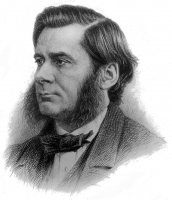| |
托馬斯·亨利·赫胥黎,FRS(英語:Thomas Henry Huxley,1825年5月4日-1895年6月29日),英國生物學家,因捍衛查爾斯·達爾文的進化論而有“達爾文的鬥牛犬”之稱。
他為了對抗理查·歐文的理論而提出的科學論證顯示出人類和大猩猩的腦部解剖具有十分的相似性。有趣的是赫胥黎並不完全接受查爾斯·達爾文的許多看法(例如漸進主義),而且,相對於捍衛天擇理論,他對於提倡唯物主義科學精神更感興趣。
作為科普工作的倡導者,他創造了概念“不可知論”來形容他對宗教信仰的態度。
他還因創造了生源論(認為一切細胞皆起源於其他細胞)以及無生源論(認為生命來自於無生命物質)的概念而廣為人知。
經歷
赫胥黎生於倫敦西部伊令,是當地數學教師喬治·赫胥黎8個孩子中的第7個。17歲時,得到奬學金,開始在查靈十字醫院(Charing Cross Hospital)接受正規的醫學教育。二十歲時在倫敦大學通過他初次的醫學士考試,解剖學及生理學兩個科目都得到最優等成績。1845年他發表了第一篇科學論文,描述了毛發內鞘中迄無人發現的一層構造,此後該層構造即被稱為“赫胥黎層”。
之後,赫胥黎前往英國海軍謀職,而獲得了即將前往托勒斯海峽進行探勘任務的軍艦響尾蛇號駐艦外科醫官的職位。響尾蛇號於1846年12月3日駛離英國,一抵達南半球,赫胥黎即埋首研究海洋無脊椎動物。他開始將他的發現內容寄回英國。他的一篇論文,“論水母科動物的解剖構造及其間的親屬關係”在1849年被英國皇傢學會的“哲學會報”刊出。赫胥黎將Medusae、Hydroid及Sertularian polyps合併為一綱,並將其命名為Hydrozoa綱。他發現此綱生物的共同點是具有由雙層膜所包圍形成的中央空腔或消化道。這就是現在所稱刺胞動物門(Cnidaria)的特徵。他並且把這個特徵比作存在於較高等動物的胚胎中的漿液性和粘液性構造。
赫胥黎的成就受到肯定,而在1850年返英時獲選為皇傢學會院士。翌年,他不僅以26歲的年紀獲頒皇傢奬章,而且還獲選為評議會議員。
1883年,赫胥黎鄭重的宣稱海洋資源不會枯竭,並呼籲政府放寬限製,讓漁民盡情捕撈鱈魚。但由於赫胥黎未能料到後來相關技術的快速發展,最後卻導致大西洋鱈魚面臨滅絶的危險。
他的健康狀況從1885年開始惡化。1890年他從倫敦搬到港口城市伊斯特本,受盡疾病折磨後在那裏去世。
赫胥黎傢族是英國著名的學術世傢,托馬斯·亨利·赫胥黎的孫子朱利安·赫胥黎爵士是聯合國教科文組織首任主席並創立了世界自然基金會,朱利安的同母弟弟奧爾德斯·赫胥黎是作傢,異母弟弟安德魯·赫胥黎爵士是生理學家,諾貝爾奬得主。
赫胥黎的傳世名言:“試着去學一切的一點皮毛,和某些皮毛的一切。”(Try to learn something about everything and everything about something.)
參見
參考文獻
- ^ 有爭議。Bibby, Cyril. 1959. T. H. Huxley: scientist, humanist and educator. Watts, London. p. 3–4
外部鏈接
Thomas Henry Huxley PC FRS HonFRSE FLS (4 May 1825 – 29 June 1895) was an English biologist and anthropologist specialising in comparative anatomy. He is known as "Darwin's Bulldog" for his advocacy of Charles Darwin's theory of evolution.
The stories regarding Huxley's famous debate in 1860 with Samuel Wilberforce were a key moment in the wider acceptance of evolution and in his own career, although historians think that the surviving story of the debate is a later fabrication. Huxley had been planning to leave Oxford on the previous day, but, after an encounter with Robert Chambers, the author of Vestiges, he changed his mind and decided to join the debate. Wilberforce was coached by Richard Owen, against whom Huxley also debated about whether humans were closely related to apes.
Huxley was slow to accept some of Darwin's ideas, such as gradualism, and was undecided about natural selection, but despite this he was wholehearted in his public support of Darwin. Instrumental in developing scientific education in Britain, he fought against the more extreme versions of religious tradition.
Originally coining the term in 1869, Huxley elaborated on "agnosticism" in 1889 to frame the nature of claims in terms of what is knowable and what is not. Huxley states
Use of that term has continued to the present day (see Thomas Henry Huxley and agnosticism). Much of Huxley's agnosticism is influenced by Kantian views on human perception and the ability to rely on rational evidence rather than belief systems.
Huxley had little formal schooling and was virtually self-taught. He became perhaps the finest comparative anatomist of the later 19th century. He worked on invertebrates, clarifying relationships between groups previously little understood. Later, he worked on vertebrates, especially on the relationship between apes and humans. After comparing Archaeopteryx with Compsognathus, he concluded that birds evolved from small carnivorous dinosaurs, a theory widely accepted today.
The tendency has been for this fine anatomical work to be overshadowed by his energetic and controversial activity in favour of evolution, and by his extensive public work on scientific education, both of which had significant effects on society in Britain and elsewhere. Huxley's 1893 Romanes Lecture, “Evolution and Ethics” is exceedingly influential in China; the Chinese translation of Huxley's lecture even transformed the Chinese translation of Darwin's Origin of Species.

